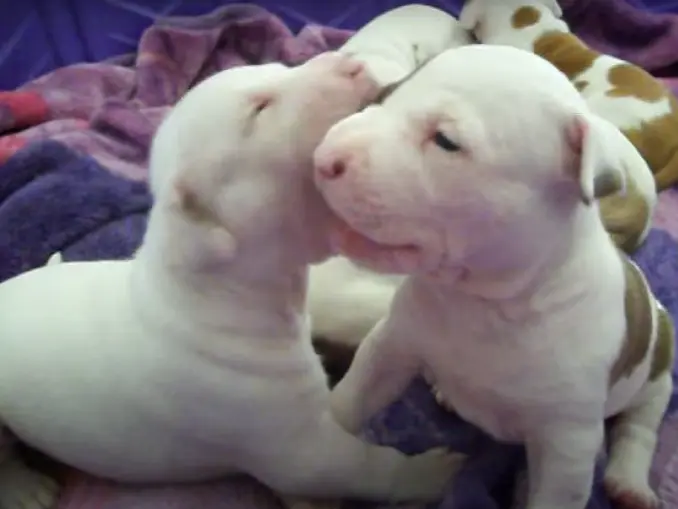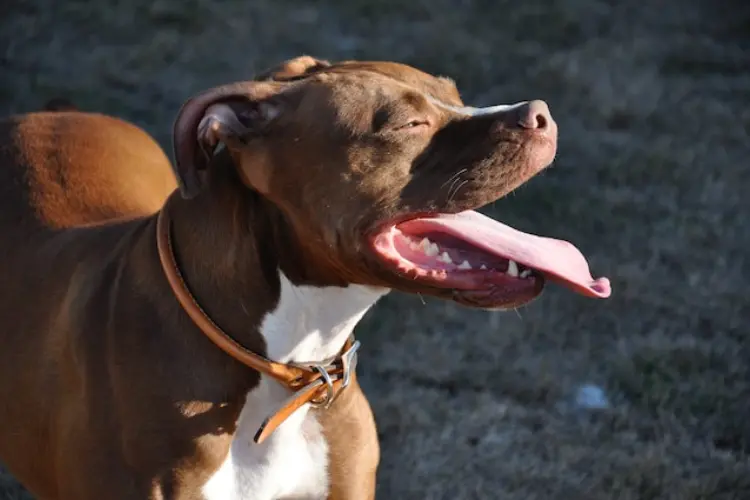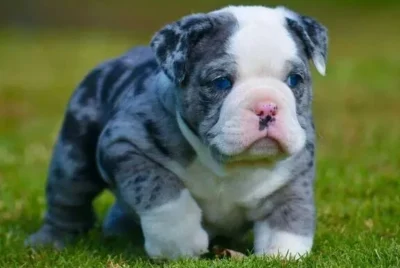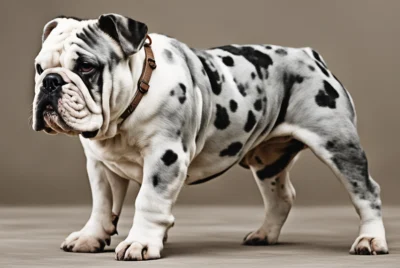Exploring the Uniqueness of Brown and White Pitbulls
Did you know brown and white Pitbulls are more than just a beautiful color combination? These gorgeous dogs have unique coat color patterns and striking features that make them stand out among other Pitbulls.
In this blog post, we’ll dive into the fascinating world of the brown and white Pitbull, discussing their beauty, genetics, care, personalities, and adoption process. So, let’s get started.
The Beauty of Brown and White Pitbulls
Brown and white Pitbulls captivate any pitbull lover with their stunning shades of brown coloration, ranging from mild, sandy to rich chocolate brown. The beautiful white markings on their coat can appear on their chest, snout, or paws, adding a striking contrast to their brown base color.
The unique distribution of these white markings is determined by the presence or absence of certain genes passed down from their parents, making them truly remarkable dogs to behold.
Coat Color Patterns
Brown and white Pitbulls can exhibit various breathtaking coat color patterns, including:
- Brindle: characterized by a stunning mix of brown and black stripes on a brown base color, giving these dogs a striking appearance.
- Piebald: evident through patches of white on a primarily brown coat, creating a unique and visually appealing pattern that can be represented in various colors and patterns within the Pitbull breed.
- Ticking: characterized by small spots or flecks of color on a white or light-colored background.
Eumelanin and pheomelanin, the two types of melanin, shape the distinctive color combinations seen in white and brown Pitbulls.
Read also: The Black English Bulldog: Essential Traits and Care Tips

White Pitbull Dog Features
White Pitbulls are just as captivating, boasting distinct features such as beautiful blue or amber eyes, a unique pink nose, and stunning white fur, which can be complemented with brown markings. These attractive features make white Pitbulls stand out from the crowd, and their rarity adds to their charm.
White Pitbulls, including the nose Pitbull variety, have a pink nose as a result of a dilute gene reducing melanin production in their coat, which leads to lighter pigmentation. The gorgeous types of brown markings seen on white Pitbulls can include:
- dark brown
- tan
- brindle
- fawn
- yellow
- black patches
Adding an extra layer of beauty to their already stunning appearance. With their luxurious, smooth-textured fur coat, white Pitbulls are truly a sight to behold.
Genetics Behind Brown and White Pitbulls
The intricate genetics of brown and white Pitbulls involve an interesting interplay of dominant and recessive genes, shaping their coat color and patterns. For example, the stunning red nose or pink tint on the face of brown Pitbulls, such as the red nose pitbull, is due to a genetic mutation that enhances the pigmentation of their coat, making them a beautiful addition to any backyard or home.
Dominant and Recessive Genes
The interaction of dominant and recessive genes offers an intriguing method to determine a dog’s coat color. Each gene is responsible for a specific trait or characteristic related to coat color. The dominant allele of a gene will take precedence over the expression of the recessive allele.
For example, the E allele is dominant to the e allele, which determines the ability to produce eumelanin in the coat. Dogs with the EE or Ee genotype will show off eumelanin in their coat, while dogs with the ee genotype will have a beautiful red coat color.
The D (dilute) locus and the TYRP1 gene are associated with the stunning brown and white coat colors of Pitbulls. Yes, two brown Pitbulls can absolutely produce a white offspring, showing how fascinating the genetics of these dogs can be.
Breeding for Brown and White Coats
Producing brown and white Pitbulls necessitates a grasp of genetics and meticulous parent selection. It involves sourcing a male and a female Pitbull that both possess the brown and white coat color. Breeding two Pitbulls with this coat coloration increases the chances of producing offspring with the same coloration.
By consciously mating dogs with preferred coat colors, selective breeding can effectively yield a brown and white Pitbull. Breeders can confidently select dogs with brown and white coats as parents and continue to breed them together over multiple generations to effectively establish and enhance the desired color pattern.

Caring for Your Brown and White Pitbull
Taking care of a brown and white Pitbull entails thorough grooming, coat upkeep, and vigilance towards potential health problems. Regular grooming and coat maintenance can help keep their coats in excellent condition and can help avoid skin problems, allergies, and other health issues.
In addition, regular vet visits, health screenings, and watching informative videos can ensure that your pitbull stays healthy and happy.
Grooming and Coat Maintenance
For brown and white Pitbulls, maintaining their coats through grooming is vital for their vibrancy and aesthetic appeal. The ideal grooming tools for a Pitbull’s short coat include:
- Pin brush
- Bristle brush
- Rake
- Deshedding brush
- Rubber brush
A brown and white Pitbull should be bathed about every 2 to 6 months for optimal results. By using the right tools and techniques, you can help keep your Pitbull’s coat looking its best while also promoting overall health and well-being.
Health Considerations
For brown and white Pitbulls, health considerations encompass potential skin problems and sun sensitivity owing to their lighter coat color. To prevent sunburn in Pitbulls with lighter coats, special care can be taken, such as:
- Avoiding prolonged outdoor time during peak UV hours
- Using sunscreen labeled explicitly for dogs with at least SPF 30
- Applying lotion or cream formulations of sunscreen
- Considering sun outfits or protective clothing
- Keeping the dog indoors or in shaded areas when the sun is intense
Health screening tests recommended for brown and white Pitbulls include:
- Hip evaluation
- Elbow evaluation
- Ophthalmologist evaluation
- D Locus (Dilute) DNA test
- Centronuclear myopathy DNA test
By staying proactive and addressing potential health concerns, you can help your brown and white Pitbull enjoy a long, happy life.
Brown and White Pitbull Personalities
Brown and white Pitbulls are known for their affectionate and loyal personalities, making them great companions for families and individuals.
They share the same loving, loyal, and protective personalities as other Pitbull color variations, including the brown pitbull, proving that the color of a Pitbull’s coat does not determine its personality traits.
With proper socialization and training, brown and white pit bull terrier dogs, like the bull terrier, can develop into well-rounded dogs with a strong desire to please their owners. These dogs can overcome the pit of negative stereotypes and thrive as loving companions.
Affectionate and Loyal Companions
These dogs are truly wonderful pets for those who can provide them with the love and care they deserve, as they are incredibly loving and loyal. Brown and white Pitbulls are renowned for their warm and affectionate personalities, often expressing their love by:
- happily leaping towards your face
- cuddling and leaning against you
- bringing you toys
- simply being affectionate and loyal companions.
Loyalty can be seen in individual dogs, regardless of breed, as it is influenced by factors such as training, socialization, and the bond formed between the dog and its owner.
With their friendly, affectionate, and playful personalities, brown and white Pitbulls are sure to be your faithful companion and bring joy to your life.

Training and Socialization
For brown and white Pitbulls to mature into well-mannered and amicable dogs, training and socialization are indispensable. Here are some tips for training and socializing your Pitbull:
- Start socialization early, exposing your Pitbull to a variety of people, animals, and situations.
- Use positive reinforcement, rewarding good behavior with treats, praise, and play.
- Enroll in training classes, where your Pitbull can learn basic commands and interact with other dogs.
- Stay calm and patient during training sessions, as Pitbulls respond best to calm and consistent training methods.
- Use reward-based methods, focusing on rewarding desired behaviors rather than punishing unwanted behaviors.
It is ideal to start training and socializing a Pitbull between 4 and 14 weeks of age, so that they can become comfortable with a variety of people and situations from a very early age.
While there are no specific training techniques used exclusively for brown and white Pitbulls, positive reinforcement techniques such as clicker training and reward-based training are highly effective for training Pitbulls.
Starting training from day one and maintaining a calm and patient approach throughout the training process is key to successful training.
Adopting a Brown and White Pitbull
When adopting a brown and white Pitbull, you need to do thorough research to identify reliable breeders or support shelters and rescue organizations. Whether you choose to adopt from a breeder or a shelter, it’s important to ensure that they prioritize the best interests of the dogs they breed or care for.
Finding Reputable Breeders
In order to find a trustworthy pitbull breeder, one should:
- Look for positive feedback from other breeders and dog owners
- Check for membership in respected breed registries
- Request health screening records
- Ask about participation in dog shows and awards won
- Seek professional recommendations
- Request visits
Reputable pitbull breeders typically have certifications such as APBR Kennel Certification, AKC certification, and certifications from organizations like OFA (Orthopedic Foundation for Animals).
By doing thorough research and choosing a reputable breeder, you can ensure that you are adopting a healthy, well-bred brown and white Pitbull puppy with the best possible start in life.
Supporting Shelters and Rescue Organizations
Backing shelters and rescue organizations can contribute to saving the lives of brown and white Pitbulls who need nurturing homes. Some ways you can support Pitbulls include:
- Providing shelter for them
- Conducting adoption programs
- Advocating for the breed
- Offering training and behavior rehabilitation
- Collaborating with others to raise funds and resources
Animal shelters and rescue organizations are doing incredible work to support Pitbulls in these ways.
The process of adoption from a Pitbull rescue organization or shelter typically involves the following steps:
- Researching the organization
- Submitting an application
- Going through an interview and approval process
- Participating in a meet and greet
- Paying an adoption fee
- Completing paperwork
- Potentially receiving post-adoption support
By supporting and adopting from animal shelters or rescue organizations, you can save lives, support local shelters, experience unconditional love, and give deserving animals a second chance in a foster home.
Frequently Asked Questions
What are the rarest colors of Pitbulls?
The rarest colors of Pitbulls are black, black and tan, white, red-nosed chocolate, light fawn, red, white and black, and red brindle. These colors are quite rare in the breed and are characterized by unique markings.
Which pitbull is rare?
White Pitbulls and Blue Pitbulls are both rare breeds due to their recessive gene and lack of pigment in the body respectively. Because albino dogs are prone to disabilities and health problems, it is advised not to breed them purposefully or purchase them.
How rare are white Pitbulls?
White Pitbulls aren’t exactly common, but that doesn’t mean they don’t exist! Breeders may not produce dogs that are over 80% white due to the AKC’s discouragement, but some breeders still do and you might be able to find one at rescues and shelters.
What is the temperament of a brown pitbull?
Brown Pitbulls are loyal companionship, intelligence, strength, confidence and zest for life. They make excellent family members and have a strong desire to please, while also exhibiting high levels of energy that require daily activity and mental stimulation. They have a friendly and outgoing temperament, but can be quite strong-willed.
Conclusion
The brown and white Pitbulls are not just distinguished by their striking coat colors but also by their incredible personalities, resilience, and loyalty. While their appearances might be the first thing that captures one’s attention, it’s their unwavering spirit and affectionate nature that truly make them stand out.
Regardless of color, every Pitbull deserves understanding and love, but there’s no denying the unique charm that the brown and white variants bring.




